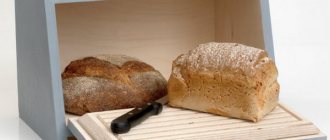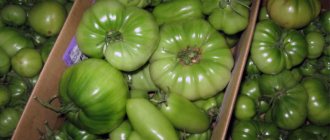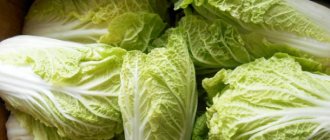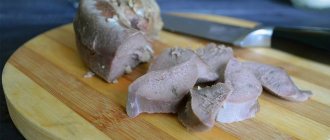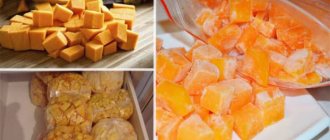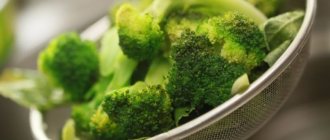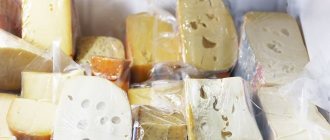What to do if the cheese is moldy. How to store cheese in the refrigerator to prevent it from molding
Recently I was “lucky” to purchase a package of moldy cheese. But every cloud has a silver lining, I wondered why in one case mold is assessed as an indicator of the unsuitability of the product, and in the other - of sophistication. It is ingrained in our minds that fresh and healthy food cannot be moldy. Then what about blue cheeses, which have long gained immense popularity among gourmets? In this article we will take a closer look at this famous blue cheese and find out whether it is possible to prepare it at home.
Is moldy cheese safe?
Mold on cheese is not always a sign of spoilage.
The molds used to produce certain varieties are different from those that sprout on your old cheese and bread.
Those used to make cheese are safe to eat. They are characterized by blue streaks on the inside of the cheese or a thick white rind on the outside—whereas typical mold is a fluffy growth that varies in color from white to green (1).
In addition to appearance, smell can also indicate the presence of mold. However, because some cheeses are naturally smelly, you should try to remember the smell after purchase to establish a baseline. This way you can evaluate its freshness after a while.
Be aware that dangerous spores can also occur on blue cheeses. They are similar to those that grow on other foods.
When should you throw away moldy cheese?
If you notice mold on your cheese, you don't have to throw it away.
Spores rarely spread far beyond the surface of hard cheeses such as Parmesan, Colby, Swiss, and cheddar. This means the rest of the product is probably safe to eat. To save it, cut at least 2.5 cm around and deep (1, 4).
However, this method does not apply to soft, crushed or sliced varieties.
Any sign of mold on these types, including cream cheese, cottage cheese, and ricotta, means it should be thrown out immediately—the spores can easily contaminate the entire product (4).
Although mold is used to produce blue and soft ripened cheeses, its appearance on other types of cheese is a sign of spoilage. If spores appear, soft cheeses should be thrown away, but hard cheeses can be saved by cutting off the moldy area.
Is mold dangerous?
Dangerous forms of mold are those that produce mycotoxins and aflatoxins. These toxins can negatively affect our respiratory system and, in some cases, even act as carcinogens. But not all mold produces harmful toxins. Special types of mold Penicillium Roqueforti and Penicillium Glaucum, which are used to make blue cheeses, do not produce harmful substances. The combination of acidity, salinity, humidity, temperature and oxygen saturation creates an environment far from producing harmful toxins. Moreover, P.Roqueforti and P.Glaucum have antibacterial properties and help fight pathogens.
Photo: wikihow.com
Unfortunately, large food manufacturers, having processed the minds of several human generations, assured us that only a homogeneous structure in vacuum packaging with a large corporate logo guarantees safety. And a moldy, rustic, unusual home-made product is tantamount to uncontrolled unsanitary conditions. But we understand that artisan foods, on the contrary, are healthier than highly processed foods.
Blue mold produces a unique effect on cheese. Mold dramatically accelerates two processes: proteolysis (the breakdown of proteins) and lipolysis (the breakdown of fats). As a result, the cheese acquires a special structure and a strong pungent aroma. The taste of cheese cannot be compared with anything else.
The dangers of eating moldy cheese
Mold can harbor harmful bacteria, including E. coli, Listeria, Salmonella, and Brucella, which can cause food poisoning (5, 6).
Symptoms of food poisoning include vomiting, abdominal pain and diarrhea. In severe cases, this can lead to death.
Harmful molds can also produce mycotoxins, the effects of which range from acute food poisoning to immunodeficiency and even cancer. In particular, the carcinogen aflatoxin has been shown to increase the risk of liver cancer (1, 7, 8, 9, 10, 11).
The best way to minimize the risk of exposure to mycotoxins is to avoid eating moldy foods and practice safe food storage practices (9, 10).
Harmful mold can carry bacteria and mycotoxins that can cause food poisoning, immunodeficiency, and even cancer.
What to do if the cheese is moldy or dried out
Cheese is a living organism, so the appearance of mold on it is a natural result of fermentation of bacteria - mold fungi. Failure to comply with storage conditions, namely high temperature and humidity, leads to spoilage of the product. You can avoid this if you purchase cheese in small portions and adhere to the storage rules specific to a particular variety.
If mold appears on hard and semi-hard varieties, it can be carefully cut off and the product can continue to be used as food. However, if soft cheese becomes moldy, it is better not to risk it and throw it away.
Dried cheese can be saved by soaking it in milk for several hours. If this does not help, you should heat the milk a little. However, such a product should not be consumed directly; it is better to use it only for preparing hot dishes and sauces.
How to store soft and cream cheeses
Curd and cream cheeses such as mozzarella, ricotta and chèvre have a limited shelf life unless preservatives are added to the product.
Large pieces of mozzarella can also be stored wrapped in cling film, provided that you change it daily for fresh ones. When refrigerated, the product remains edible for 7 days. Mozzarella balls dry out quickly, so it is best to store it in brine. When using clean cutlery, the whey retains freshness for a long time. But if the brine changes its smell or color, this means that pathogens have entered the liquid. It needs to be replaced urgently - for example, with a salt solution (1 tsp per 2 cups of cooled boiled water). Photo: Getty Images Related: 10 Foods You Shouldn't Refrigerate (But We Do Anyway) Is it safe to cut mold off bread and eat it? Why dairy products spoil and how to avoid it
Cooking technology
Before we move on to cooking, let's touch on the important aspects of this process.
Blue mold only grows during a certain period of time - the ripening of cheese. Since mold requires a special acidity, it cannot grow in cheese that is too young and still sour. At the same time, mold grows due to nutrients that are not available in sufficient quantities in already mature cheese.
Mold spores are highly contagious to other cheeses. Therefore, you should limit blue cheeses from other types of cheeses during this sensitive period.
Proper mold growth is ensured by access to large amounts of oxygen. Therefore, the cheese is pierced with a massive needle or knitting needle so that oxygen enters the cheese through the formed channels. The breathing mold begins to grow from the center of the head to its surface, creating a beautiful contrast of blue “veins” with the marbled color of the cheese itself. Cheese makers repeat the piercing procedure daily for a week or two.
Photo: wikihow.com
The cheese is then wrapped in foil, thereby preventing uncontrolled mold growth. The cheese is placed at a cooler temperature, allowing the mold to create a deep, complex structure, aroma and flavor. In some cases, this last stage can take up to several months.
Cheese crystals
Not all food that develops white spots goes bad. In fact, they may be a good sign for your culinary quest. For example, sweet potatoes may have a white coating or spots if they are particularly sweet.
While you may be predisposed to think that any white spots on the cheese are mold, old and true Parmigiano Reggiano may form crystals rather than mold, and this would actually be a very good thing.
As some cheeses age, the proteins break down, causing a change in texture and flavor. The texture may be slightly crunchy and the flavor may be particularly sweet or savory.
There are two types of cheese crystals that can form in aged cheese but do not form in imitation Parmesan: tyrosine crystals and/or calcium lactate.
Her Majesty Mold
Mold is a whole collection of microscopic fungi, the bacteriological varieties of which number more than 300,000 species. Most mushrooms are poisonous, and, as scientists have proven, the poison is not excreted, but accumulates in the human body to deal a crushing blow to its organs. Mold develops its structure especially easily in soft cheeses, choosing both expensive varieties such as Brie and Munsten, as well as more budget options.
We recommend reading: Has the Curd Buttercream Spoiled in Lumps in the Freezer or Not!?
Mold structure:
- Root - mycelium is a mycelium, the roots of which are able to penetrate deep into the cheese pulp.
- Hyphae stalks - sporangiophores - originate from the mycelium, thread-like pass through the pulp and cover the walls of the product.
- Sporangia - heads with numerous spores, visually represent a fur fluff on the surface of the cheese.
Unfortunately, not always, when you cut the cheese, you can see the roots of the mycelium, and it is around them that there can be poisonous toxic waste products of mold - mycotoxins. Microscopic fungi can infect the skin, intestines, liver and lungs of humans. If the cheese has been moldy for a long time, and the fungi have managed to infect the product with mitotoxins, then this is already dangerous to health.
Mold diseases:
- food poisoning;
- diseases of the respiratory system, bronchitis, bronchial asthma;
- aspergillosis - damage to the lungs with intense hemoptysis;
- cirrhosis and liver cancer (caused by multiple accumulation of mitotoxins);
- allergic reactions.
An allergy to blue cheese is manifested by severe fever, cough with sputum and even attacks of suffocation. According to statistics, 70% of allergy sufferers and asthmatics surveyed consider the presence of mold on cheese products to be completely harmless. However, most people also mistakenly think that all spoiled cheese can be revived by cutting off the mold-infected crust from its surface and using the rest for food. This is not entirely true, and the solution to the “throw away or prune” dilemma depends directly on the variety.
Unfortunately, not always, when you cut the cheese, you can see the roots of the mycelium, and it is around them that there can be poisonous toxic waste products of mold - mycotoxins. Microscopic fungi can infect the skin, intestines, liver and lungs of humans. If the cheese has been moldy for a long time, and the fungi have managed to infect the product with mitotoxins, then this is already dangerous to health.
Still not worth the risk
Poisoning, dysbacteriosis, heartburn - these are just some of the consequences that can overtake you if you eat a moldy piece of soft cheese on its own. Some outcomes can be truly disastrous, so do not risk yourself and your loved ones and monitor the state of food in your home!
If you're not sure what type of cheese you have or what to do if it grows mold, your safest bet is to discard it. It’s not worth taking risks, because this is your life and your health, you don’t want to ruin everything. Be careful and vigilant and eat healthy and fresh food that will not harm your body!
Imagine the situation: you take cheese out of the refrigerator and find areas of fluffy white or green mold on it. What should you do: throw away the cheese or just cut off the mold? What about mold on strawberries or bread?
The answer to the question of whether it is safe to eat moldy foods depends on the type of food. Generally speaking, on hard foods like cheddar cheese or carrots, you can trim off the moldy area (plus 1 inch around) and eat the rest.
As for “softer” products, it is better to avoid them, since mold roots can penetrate very deeply, even if the surface of the product remains clean and unaffected. Meanwhile, mold can be very dangerous...
What is mold?
Mold is a type of microscopic fungus. There are more than 300,000 different species of fungi, most of which have a thread-like structure and form spores that are easily spread by air, water and insects. Mold consists of 3 main parts:
- root part - mycelium, mycelium (which can grow deep into products);
- “stems” - the visible part that rises above the surface of the product;
- spores at the end of the “stalks” (they determine the color of the mold).
Should you deal with mold yourself?
If you want to make blue cheese at home, be prepared for difficulties. First of all, because of the cheese itself. Store-bought cheese is unlikely to work. It is usually already aged, so the blue mold will not have enough nutrients to support growth. Competition from yeast in the crust will simply prevent blue mold from growing. Therefore, it is necessary to find young cheese with or without a thin rind. Daredevils can try making their own cheese.
We also do not forget about the need to create a large number of cavities inside the cheese for sufficient oxygen penetration inside. Regular puncture also carries the function of “infecting” the cheese with mold.
If you can't find blue mold commercially, you can scrape it off moldy rye bread or other blue cheese. Although you can do it easier - grind a piece of blue cheese in a blender, adding a small amount of water and a pinch of salt to the container.
After making fun of the head of cheese, turn it on its side. This will make it easier for air to pass through the cheese. Set the air temperature at 13°C, humidity should be 90-95%. Once the mold has grown enough, refrigerate the cheese for a few more weeks or months.
The process is quite complex and meticulous.
How and why are mold fungi used?
Some “varieties” of molds are actively used in medicine and the food industry.
With the help of yeast - microscopic fungi that do not have a developed mycelium and grow as individual or linked swollen cells - they make alcoholic drinks (beer, wine), bake bakery products, produce sausage products, prepare sauerkraut and pickle cucumbers.
Top articles: How and how long can you store cooked rice for sushi and rolls?
In winemaking, special attention is paid to mold fungi. The grapes, covered with a sufficient amount of mold, are harvested at a certain time and put into production - the production of elite dessert wines
Gray botrytis (lat. Botrýtis cinérea) is an imperfect stage of mold fungus that constantly lives in the soil and on plant debris, causing the appearance of gray rot on plants - increases the concentration of sugar in grapes, making the taste of the drink more intense.
In Europe they love cheese with noble mold (brie, Camembert, French Roquefort, English Stilton, Italian Gorgonzola, Danish blue cheese - Danablue). Blue cheese first appeared a couple of thousand years ago. Previously, to prepare it, fresh bread was left in a cave for several weeks. After this, the bread, already fairly moldy, was dried, thoroughly crushed and the resulting powder was added to the cheese. Now, of course, no one does this, and edible types of fungus are grown in laboratories. When it comes to agriculture, molds are more of a pest than something beneficial. However, there are exceptions to everything. For example, some varieties of Fusarium (despite the fact that because of its other varieties, plants rot and animals get sick) living in the soil, on the roots of plants (for example, wheat) have a positive effect on the development of the plant, enhancing its growth.
In Eastern countries, some types of mold have long been used in the production of soy foods and various sauces.
The dreaded black mold is used as the main ingredient in the production of citric acid.
Mold is an amazing “thing”; it can either save a person’s life or take it away.
Of course, it is also necessary to pay tribute to the first antibiotic - penicillin. How was it created? This happened in September 1928, and completely by accident. Scottish biologist Alexander Fleming had an assistant. One day, leaving the laboratory in the evening, he forgot to close the window for the night. And in the morning it was noticed that the samples of staphylococci, which were in an open container, were covered with unknown spores. The “spoiled” material was almost thrown away, but at the last moment they decided to study it under a microscope. As it turned out, the spores landing directly on the bacteria killed them, thus preventing further reproduction.
Later studies proved that mold fungi do not neutralize all microbes, but only some, mainly pathogenic ones. Fleming isolated an active substance from mold fungi that destroyed bacterial cells and called it penicillin (in honor of the miraculous mold fungi). The work was published in 1929. However, the scientist did not expect that it would be so difficult to obtain penicillin in its pure form. His initiative was continued by Howard Florey and Ernst Boris Chain, they developed several methods for purifying penicillin.
Mass production of penicillin began during World War II.
In 1945, Fleming, Florey and Chain received the Nobel Prize in Medicine or Physiology.
The properties of penicillin were appreciated and began to be used in the treatment of various bacterial infections.
I like it I don't like it
How to grow mold on cheese
Growing blue cheese comes with its own challenges. Today, there are harmless strains of bacteria bred in laboratories, but such mold can also be toxic. It is important to strictly adhere to the recipe and not violate the technology for preparing the product.
Cheeses with white mold
To produce white mold, two types of bacteria are used - Penicillium candidum and Geotrichum candidum. The first type is suitable for making cheeses based on cow's milk.
The PC strain covers the product with a solid fluffy mold. The mass itself, under the influence of bacteria, becomes soft and viscous.
The GEO strain is used for the preparation of goat milk products. This type of mold is also often mixed into the base to prepare the cheese mass for the growth of Penicillium candidum. This is how the Camembert variety is prepared.
Soft cheese
When making such cheeses, careful processing is not carried out, as a result of which you can find products without shells on store shelves. Prominent representatives of soft cheeses are considered to be Tofu, Philadelphia, Mascapone, and Mozzarella. The taste of the products varies greatly; they can be creamy, mushroom, or with the addition of bacon.
- An important feature of storing soft cheeses is considered to be low temperature. The product can last in the refrigerator at sub-zero temperatures for about 3 days.
- Like other types, this type of cheese must be carefully packaged before refrigeration. An excellent option would be a plastic sealed container or an enamel container with a tightly closed lid.
- You cannot store soft cheese with other types of dairy products, otherwise it will absorb the smell and begin to deteriorate at an incredible speed.
How to protect cheese from white mold
Do not store cheese in cling film
Cheese is a living product that requires natural ventilation. The film creates a “greenhouse effect” and increases the humidity inside the package—in such conditions, microorganisms multiply faster. In addition, plastic changes the taste and smell of cheese. And the fattier the product, the worse it becomes.
Buy cheese bags or paper
If your family loves cheese or you make it yourself in fairly large quantities, pay attention to special bags and paper for storing dairy products.
They are made of a porous material (most often, two-layer wax-coated parchment or thin polyethylene plastic) that allows the food to “breathe” and extends its shelf life by at least two weeks.
Special cheese paper can be replaced with regular baking parchment.
Wrap the piece in paper and place it in a thick plastic bag, making several cuts in it. The parchment will prevent the food from coming into contact with the plastic and will protect it from drying out.
Change packaging as often as possible
Many cheeses with a high percentage of fat begin to release moisture over time, creating favorable conditions for the growth of moldy fungi. To keep the product fresh longer, change the packaging - be it parchment, a bag or foil - every time you cut a new piece from the cheese.
Save production date information
“Live” dairy products should not be eaten after the expiration date. Every time you change the packaging, do not forget to attach a sticker to it with the date of manufacture of the product - this way you will eliminate the risk of eating expired cheese.
Store cheese in the vegetable drawer
The ideal temperature for storing hard cheese is 2-7 degrees. At lower temperatures, the texture of the product changes, and at higher temperatures, it “floats” and quickly deteriorates. To extend the shelf life of cheese, store it in the vegetable drawer or on the bottom shelf of the refrigerator.
Storing cheese depending on the variety
Let's consider how much and under what conditions each type of cheese should be stored.
| Name | Shelf life | Storage conditions |
| Solid | Up to 14 days | +3-7 degrees, humidity above 85% in a spacious film package or in food parchment. If mold is found, it must be carefully removed. It is recommended to let it sit at room temperature for 15-30 minutes before serving. This way the microorganisms will “come to life” and the taste will become more intense. |
| Soft | Up to 3 days from the moment the package is opened. Packed for up to a month. | In packaging at a temperature of -2-4 degrees, without it at +3-8. Be sure to pack carefully. These varieties dry out quickly. When mold appears, food should not be consumed; harmful microorganisms quickly infect not only the surface, but also the inside. |
| Brine | Up to three months | Only in its own brine and hermetically packaged at a temperature of +2-4 degrees. For suluguni you need to make a special brine - 200 grams of salt per liter of water. Before immersing it, a piece of cheese must be soaked in milk for an hour. Rinse with water before eating |
| With mold | Up to a month | If the packaging is sealed, you don’t have to put it in the refrigerator, but you can’t expose it to direct sunlight. If it has been unpacked, it is better to put it in an airtight container and put it in the refrigerator. |
| Melted and homemade | Up to 5 days | It should be kept at temperatures up to +5 in a glass or enamel container. Homemade products can be cut and frozen |
| Smoked | Up to 75 days in original packaging up to a week when opened | At temperatures up to +4, humidity about 85% |
| Tofu | Up to three months | In cold distilled water. It must be changed daily. The packaging must be sealed to prevent contact with air |
Cheese crystals or mold?
How can you tell if white spots on cheese are crystals or mold? Your first clue is the quality of the cheese.
True Parmigiano-Reggiano is more likely to have crystals and is unlikely to develop mold because it is a very low moisture content cheese.
The next clue is whether the stains are on the inside of the cheese or on the outer layer. If they're inside the cheese, they're almost guaranteed to be crystals. This will add a nice hint of flavor to your already delicious Parmesan.
If you're still not sure, give it a try. Even if it is on the outside of the cheese, it may not be mold.
A small amount of mold isn't likely to hurt you unless you have an allergic reaction to it, but it will give your taste buds a chance to tell you whether it's a good or bad addition to your cheese.

